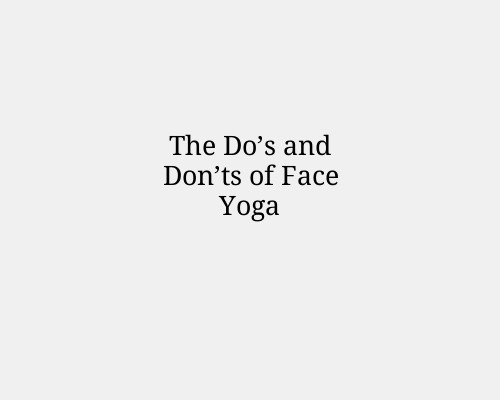
The Do’s and Don’ts of Face Yoga for Anti-Aging
Face yoga, a series of facial exercises designed to tone the muscles beneath the skin, has gained popularity as a natural method for combating signs of aging. While not a miracle solution, when done consistently and correctly, it may help improve facial muscle tone, reduce tension, and enhance skin appearance. However, like any wellness practice, there are essential guidelines to follow. This article outlines the key do’s and don’ts of face yoga for anti-aging to help beginners approach it safely and effectively.
What is Face Yoga?
Face yoga involves a combination of facial exercises, stretches, massage techniques, and controlled breathing. The practice focuses on targeting specific muscle groups in the face and neck to improve circulation, stimulate collagen production, and relieve tension. Advocates claim it helps reduce wrinkles, lift sagging skin, and improve facial symmetry.
Scientific studies on face yoga are still limited, but early evidence, including a 2018 study published in JAMA Dermatology, suggests that consistent practice over several weeks can lead to visible improvements in facial fullness and reduced signs of aging.
The Do’s of Face Yoga for Anti-Aging
Do Practice Regularly
Consistency is key. Like physical fitness, facial muscles require ongoing stimulation to maintain tone and elasticity. Aim to practice face yoga for at least 20–30 minutes a day, five to six days a week, to see results over time.
Do Start with Clean Hands and Face
Before beginning any facial routine, wash your hands and cleanse your face thoroughly. This helps prevent the spread of bacteria and reduces the risk of clogged pores or skin irritation.
Do Use a Mirror
Using a mirror ensures that you’re performing exercises correctly. Incorrect technique can result in muscle imbalances or exacerbate lines rather than reducing them.
Do Focus on Breathing
Incorporating slow, deep breathing helps to calm the nervous system, improve oxygen flow to the skin, and enhance overall relaxation. This is especially helpful in reducing stress-related facial tension.
Do Combine with a Skincare Routine
Face yoga works best when paired with a proper skincare regimen. Use serums or facial oils before your session to provide slip and nourish the skin while reducing tugging.
Do Warm Up and Cool Down
Start with light facial massage or lymphatic drainage movements to warm up the muscles. Conclude with gentle stroking or tapping motions to cool down and stimulate circulation.
Do Listen to Your Face
If a particular movement feels uncomfortable or causes pain, stop immediately. Discomfort is a sign that you may be doing the exercise incorrectly or applying too much pressure.
The Don’ts of Face Yoga for Anti-Aging
Don’t Expect Immediate Results
Face yoga is not an overnight solution. Visible results typically take weeks or even months of consistent effort. Be patient and manage your expectations accordingly.
Don’t Tug or Pull on the Skin
Avoid any movement that stretches the skin aggressively. Excessive pulling can damage skin elasticity, leading to more wrinkles over time.
Don’t Use Dirty Hands or Tools
Touching your face with unclean hands or using unwashed tools like rollers or gua sha stones can introduce bacteria and cause breakouts or skin infections.
Don’t Overdo It
More isn’t always better. Overworking facial muscles can lead to muscle fatigue, tension headaches, or even worsen expression lines. Follow recommended durations and give your face time to rest.
Don’t Skip Hydration
Dehydrated skin is more prone to fine lines and sagging. Drink plenty of water and use hydrating skincare products post-session to lock in moisture.
Don’t Ignore Other Anti-Aging Factors
Face yoga should complement other healthy habits. Sun protection, balanced nutrition, sleep, and stress management are all crucial elements of a comprehensive anti-aging routine.
Don’t Use Face Yoga to Replace Medical Treatments
While face yoga can be a useful natural addition to skincare, it’s not a substitute for medical or dermatological procedures. For severe skin concerns or noticeable sagging, consult a licensed dermatologist or cosmetic specialist.
Common Face Yoga Exercises for Anti-Aging
The Cheek Lifter
Smile while lifting your cheeks toward your eyes.
Place fingers gently over the top of your cheeks to add light resistance.
Hold for 10 seconds and repeat 5–10 times.
The Forehead Smoother
Place both palms on the forehead and gently pull the skin outward.
Raise your eyebrows while keeping the skin taut.
Repeat 10 times to reduce forehead lines.
The Neck Tightener
Tilt your head back and push your lower lip upward.
Hold for 5 seconds and repeat 10 times to tone the neck and jawline.
The Eye Firmer
Gently press the outer corners of your eyes with your index fingers.
Squint your lower eyelids while resisting with your fingers.
Repeat 10–15 times to reduce crow’s feet and under-eye bags.
Final Thoughts
Face yoga is a low-cost, non-invasive addition to an anti-aging routine. When practiced correctly and consistently, it may improve facial muscle tone, skin elasticity, and reduce tension-related wrinkles. However, incorrect practice can do more harm than good, which is why it’s important to follow proper techniques and avoid common pitfalls.
It’s not a quick fix, nor is it a replacement for dermatological care, but face yoga can be a beneficial part of a holistic skincare approach. Start slowly, stay consistent, and support the practice with a healthy lifestyle and quality skincare for best results.